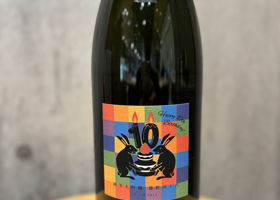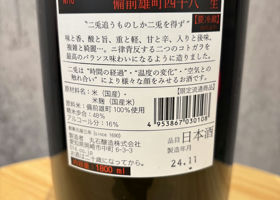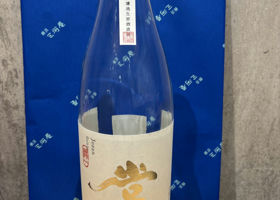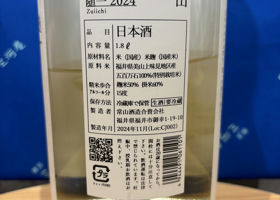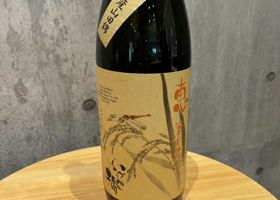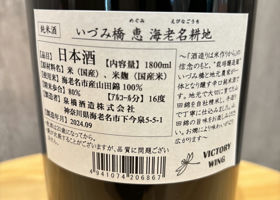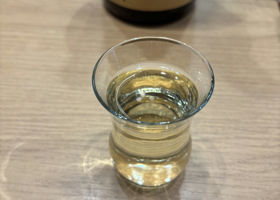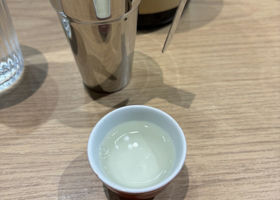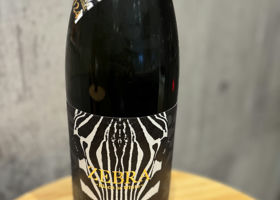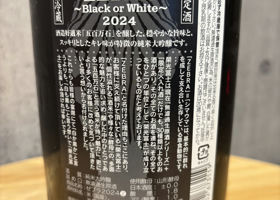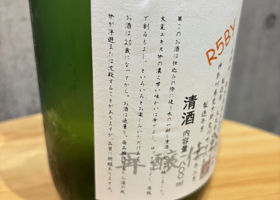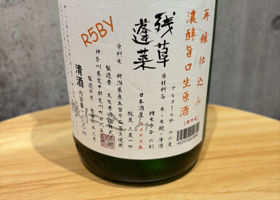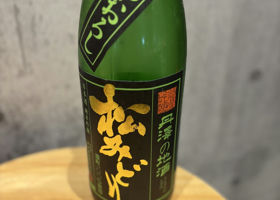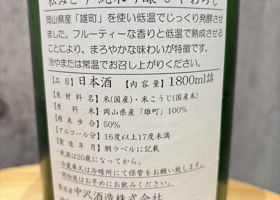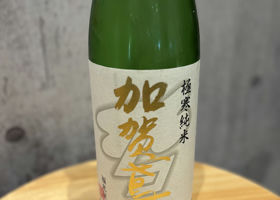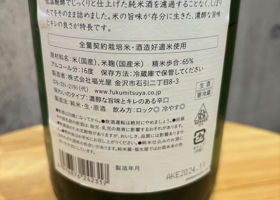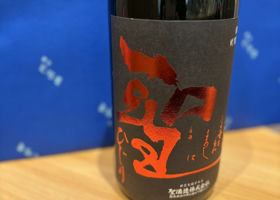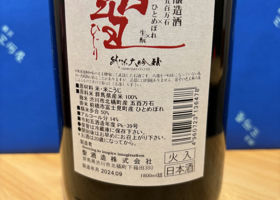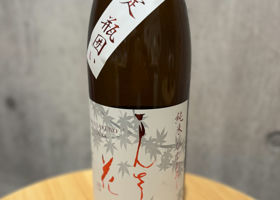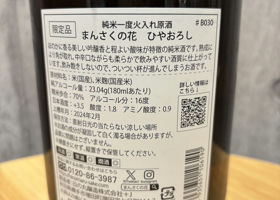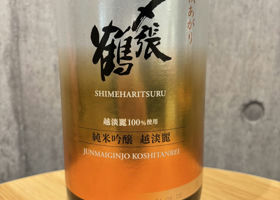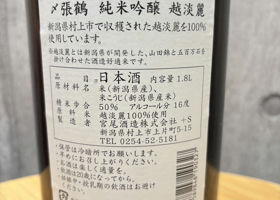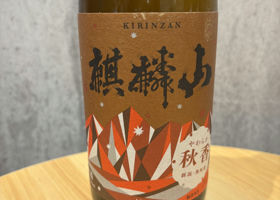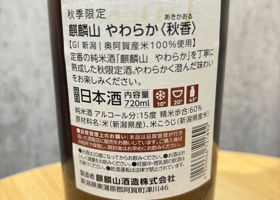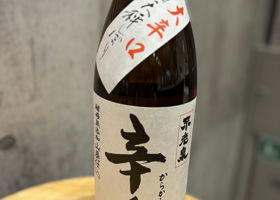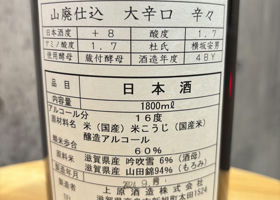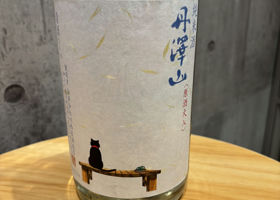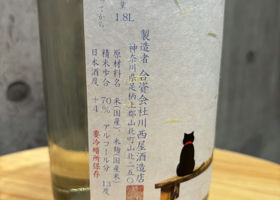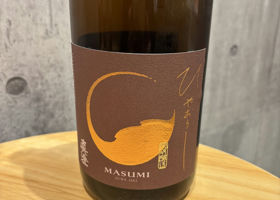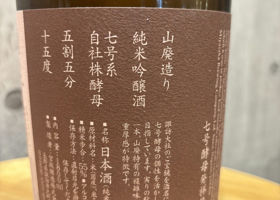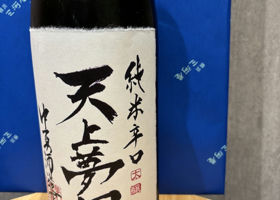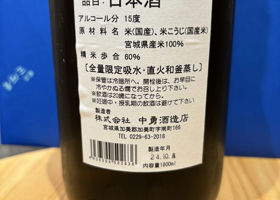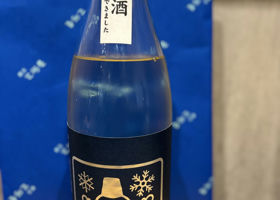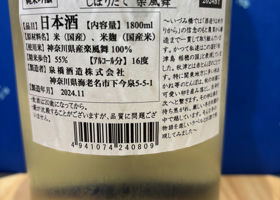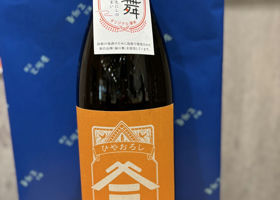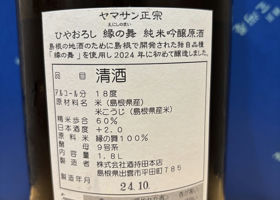Timeline
Nito純米大吟醸 備前雄町四十九生純米大吟醸生酒 越の酒好きThe first drink of the day is Ni-Utsu!
Light, dry or sweet?
Light and slightly carbonated
Fresh aroma with a hint of green.
The elegant sweetness that is typical of Omachi spreads in the mouth, followed by a light, slightly carbonated acidity.
Bizen Omachi 100%, Rice polishing ratio 48
Alcohol 16%.
Happy 10th Birthday label
Compared to the other Ni-Utsuri, it has less fullness in the mid-palate and the flavor comes through quickly.
It is sharp and delicious with umami. ☺️ jozan槽場初詰 無濾過生原酒 直汲純米原酒生酒無濾過 越の酒好きThe fifth drink of the day was Tsuneyama-san. The drink is very strong and makes you feel drunk 😅.
It is rich and dry.
Firm texture on the tongue. Slightly carbonated
Nutty aroma.
Slightly carbonated, with a firm sweetness, but with a good amount of acidity on the tip of the tongue.
100% Gohyakumangoku stone, 15% alcohol by volume
Polishing ratio 50%.
It is firm and tasty. The umami comes slowly, but there is also a moderate acidity, making it easy to drink for a Tsuneyama. 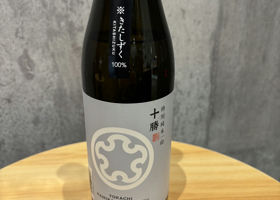
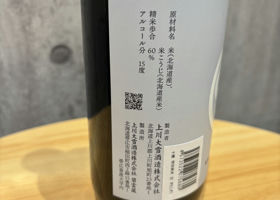
越の酒好きThis is my fourth drink of the day, but it is the second drink in terms of publication.
Each cup is 90ml, so I've already had two cups😅.
It is light and dry.
Light texture and sweet aroma.
The sweetness is felt firmly on the tip of the tongue and spreads in the mouth. The sweetness spreads in the mouth with a firm sweetness on the tip of the tongue, followed by a bit of sourness, but the sweetness prevails.
The aftertaste slowly fades away.
Kitashizuku 100% white malted rice brewed sake
The acidity is mild for a sake made with white malted rice, and the flavor is well balanced with the umami.
Many sake made with white malted rice have a strong acidity, but this sake does not have a strong acidity and is very mild and well-balanced. I think it is the most delicious sake I have ever tasted made with white malted rice!
I have always felt that sake from Hokkaido is relatively light and thin in flavor, but the sake from Kamikawa Taisetsu Brewery is beautiful and full-flavored, and I like the way they brew their sake. 越の酒好きToday I am having it again at Mikawaya in Ebina.
The first and second cups have already been mentioned, so I'll skip the third cup, Izumibashi.
It is a junmai sake and very robust, so I had it first at room temperature, then warmed up. ☺️
It is rich and dry.
The texture is firm on the tongue. The aroma of rice is typical of junmai sake.
The first taste is heavy with a big hit of umami and acidity.
The aftertaste is numbing.
100% Yamadanishiki from Ebina, 16% alc.
Polishing ratio 80
Next, we had it warmed up.
The aroma of rice doubled when heated! The acidity also mellowed a bit, making it easier to drink! 越の酒好きToday's last dish was "Eiko-Fuji". It is still delicious!
It's delicious!
The texture is rather firm on the tongue.
The aroma is gentle, like the aroma of wasanbon (a type of rice cake).
The first thing that comes to mind is the tingling sensation from the slight carbonation, and the elegant and full sweetness that spreads in the mouth. The aftertaste is a little alcoholic.
The aftertaste is a little alcoholic.
Polishing ratio 50%.
Sake degree 0.0, acidity 1.8, amino acidity 1.0
No matter which one you drink, you can never go wrong with this delicious Eiko Fuji.
In terms of specifications, it is a slightly mellow type, but it is almost in the middle of the range. It has a refreshing feeling, but at the same time, it has a delicious sweetness from Gohyakumangoku, and is just delicious.
The unfiltered, raw sake has a slightly carbonated taste, and the clean and robust umami is blissful. 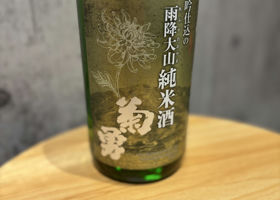
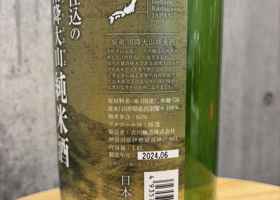
越の酒好きThis is my fourth drink of the day, but I drank it at room temperature with a solid sake, as I had a small amount earlier.
I thought about heating it up halfway through, but then I realized I was drinking it all up~!
It has a rich, mellow, sweet taste.
Firm texture on the tongue. The color is light yellowish green.
It has a strong fruity aroma, as it is made from gin.
It has a rather firm sweetness, but the sourness comes soon.
There is a sharp acidity in the aftertaste.
Polishing ratio 65%, alcohol 16%.
Yamagata Prefecture, Izuwasan 100%.
It is not a traditional Junmai-shu, but a modern Junmai-shu with a refined flavor and more gorgeousness due to the Gin-brewing process.
Even when drunk at room temperature, it has just the right amount of aroma and umami, with a slight acidity to keep you from getting tired of drinking it.
Yoshikawa-san's water is medium-hard, which gives the sake a robust flavor, but it also makes the most of this flavor to create a very tasty, umakuchi type sake.
The background of the label depicts the brewery's hometown, Mt. Daisen, which has long been revered as a sacred mountain, especially during the Edo period (1603-1868) when it was worshipped as the god of water, and people made pilgrimages to Mt.
The mountain was also known locally as "Mount Afuriyama," which is also used on the label of this sake. 越の酒好きThe third sake of the day is also from Kanagawa. This sake is very strong, so I drank it with an inokuchi (cup).
It has a rich, mellow, sweet taste.
A rich and thick texture on the tongue
Aroma of rice with increased umami.
It has a sweetness with a caramelized taste, but the acidity comes quickly.
There is almost no sharpness in the aftertaste, and it is very cloying.
Polishing ratio 60%, alcohol 16%.
Sake meter -5, acidity 3.1
100% Gohyakumangoku grown in Niigata Prefecture
Unusual for Oya? It is a very rich and umami-guchi type.
It is a so-called "kijozo-shu," a type of sake in which sake is used instead of water in the final stage of the three-stage brewing process, which makes the umami taste thicker.
I think it would be delicious with carbonated water! 越の酒好きThe second drink of the day is a local sake from Kanagawa.
Light, dry to sweet
Light texture on the tongue
Fruity aroma more like muscat than melon.
Gentle sweetness like fruit wraps around the tongue. Not much acidity.
Aftertaste is a lingering aftertaste of umami.
100% Omachi from Okayama Prefecture
Polishing ratio 50%, alcohol 16-17%.
I think Matsumidori has a good way of producing umami.
The use of authentic Omachi gives it a nice umami and aroma, and it has a delicious, mellow flavor, like eating fruit. 越の酒好きToday's sake is from Ishikawa
Light and dry
The texture is light on the tongue.
The first thing you notice is the fruity melon-like aroma, followed immediately by a moderate acidity. The sweetness comes after that.
Polishing ratio 65%, alcohol 16%, unblended sake
It has a very elegant ginjo aroma for a junmai sake, probably because it was finished slowly at a low temperature.
It is a light-bodied sake, but it has a rich flavor and dry taste that is not cloying and is easy to drink. 越の酒好きRich, mellow and dry.
A certain weight and strength on the tongue.
It has a slight greenish ginjo aroma.
PointThere is a fairly strong sweetness, but there is also an incense-like strong acidity, and a sweet and sour taste.
This sake is made from Gohyakumangoku and Hitomebore.
It is quite sweet, but the acidity is as strong as the sweetness, giving it a sweet and sour taste like citrus fruits. 越の酒好きThe texture is rather firm on the tongue.
Gorgeous ginjo aroma spreads in the mouth.
It has a fair amount of sweetness, but with a moderate acidity.
There is a sense of alcohol in the latter half.
Rice polishing ratio 70%, alcohol 16%.
Sake degree +3.5, Acidity 1.8, Amino acidity 0.9
The specs are: rich, mellow, light with a bit of umami, and a bit dry.
It certainly tastes as it should.
The aroma is elegant, and the aging process has increased the umami, making it easy to drink. 越の酒好きThe second drink of the day is also Niigata sake.
It is a light and dry sake with a light texture and a hint of nuttiness.
Light on the tongue with a hint of nutty aroma.
The sweetness with a slight sense of maturity covers the tongue like a film, although it is light. The sweetness with a slight sense of maturity covers the tongue like a film, followed by a slight astringency.
The taste is refreshingly light, but the fact that it is 100% Koshi-tanrei has helped to increase the flavor of the Koshi-tanrei.
It has a moderate sweetness, making it easy to drink and delicious. 越の酒好きToday's first drink is Niigata sake.
Drinking it in Kanagawa makes it feel more light.
It is light and dry.
It has a watery texture, but the aroma has a sense of maturity.
Light sweetness, but not too much acidity and astringency.
Polishing ratio 60%, alcohol 15 degrees Junmai-shu
It has a light texture and a refreshing taste on the tongue, but it has matured a little and its umami has increased. 越の酒好きThe fourth cup of the day was heated to warm up the sake.
The following comments are my impression of the warmed sake.
It is rich and dry.
It is quite heavy on the tongue.
The aroma of rice is very strong.
It has a strong sweetness or umami. It has a strong sweetness or umami, but it also has a lot of acidity.
Sake degree +8, acidity 1.7, amino acidity 1.7
Polishing ratio 60%, alcohol 16%.
Yamahai brewing without additive yeast
The specs are dark mellow, mellow and dry, not very dry, but quite spicy.
When heated, the mellowness increases its umami.
It has a strong acidity, which is just right for warming sake and makes me want to eat sashimi, etc. 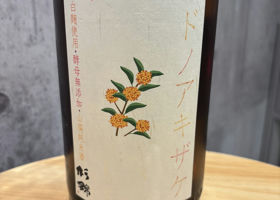
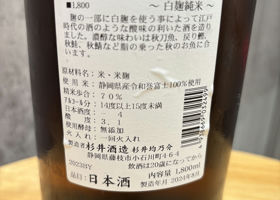
越の酒好きThe third sake of the day is the first one from Shizuoka, but it is quite a strong one made with white malted rice!
The taste is light, sweet, and dry.
The texture is light on the tongue. The color is yellow like Oronamin C.
The color is yellow like Oronamin C. It smells a little like oak, but the sour aroma unique to white malted rice prevails.
It has a slight sweetness, but the sourness peculiar to white malted rice comes strongly.
The aftertaste is sharp with sourness.
Polishing ratio: 70%, Sake meter: -4, Acidity: 3.1
Alcohol 14-15
Made with white malted rice, no additive yeast, pure rice sake from the mountains
In terms of the specifications, it is a dark, mellow, slightly sweet sake, but because it is made with white malted rice, which is not often used for sake, and because it is a pure rice sake made with Yamahai, it has a very complex acidity that is very surprising.
That said, the acidity is not too strong to make it difficult to drink, so drinking it while eating oily food may open up a new world for you. 越の酒好きToday's second drink is from a long-established local brewery in Kanagawa
Light and dry
Relatively thin on the tongue, with a slight aroma of the yellow part of pudding.
It has a light sweetness, followed by a slight sourness.
The aftertaste is a little alcoholic.
Polishing ratio 70%, Sake degree +4, 13% alc.
The overall taste is light.
The aroma is surprisingly pudding-like!
However, it is not so sweet and the sourness comes quickly, so it is less pudding-like, but this is the first Junmai sake with a pudding-like, egg-like flavor, which is good.
The back view of the cat on the label is also a bit melancholy and cute. 越の酒好きToday's first cup will be a stable Masumi.
Lightly sweet and light.
The aroma is light on the tongue and has a very elegant chestnut-like aroma.
The light sweetness is followed by a fruit-like acidity. Not so much astringency is felt.
The second half has a slight alcohol taste.
Junmai Ginjo Yamahai-zukuri with our own yeast strain No. 7
Polishing ratio 55%, alcohol 15
It has an exquisite balance of elegant sweetness and a pleasant acidity.
It is not heavy, so it is easy to drink and delicious.
Although it is a Yamahai, it has no strange habits, or rather, it has a beautiful complexity, and the aging process of hiyaoroshi gives it an increased umami flavor!
As one would expect from the originator of the No. 7 series yeast! 越の酒好きLight and dry
Firm texture
Slight aroma of rice
Sweetness is felt, but acidity is also felt to a certain extent. Overall, it is sweet and spicy.
The aftertaste is a little alcoholic.
Although it is said to be dry, it also has umami, so it is easy to drink because it is not too dry and has umami.
If it were too dry, I would not be able to drink it, but this sake was dry with umami, so I could continue drinking it.
The unique rich aroma is fresh and delicious. 越の酒好きLight and dry
Moderately firm on the tongue
It has a slight melon-like aroma with a hint of greenness.
It has a slight green melon-like aroma.
The aftertaste has a sharp acidity.
The aftertaste is sharp with acidity.
100% Raku-fu-mai from Kanagawa Prefecture
Rice polishing ratio 55%, alcohol 16
This is a new sake brewed this year, 2024BY.
It has a rather robust flavor and is very drinkable.
The rice used for Raku-fu-mai is said to be a light rice with Gohyakumangoku as its parent. It was light, but had a nice flavor and was delicious. 越の酒好きThe second drink of the day is a sake from Shimane
Light and dry
Rather light and watery on the tongue
Slightly fruity aroma
Light sweetness with a hint of sourness and astringency.
The aftertaste is alcoholic.
Alcohol 18%, Rice polishing ratio 60%, Sake meter rating +2.0
No.9 yeast
100% En-no-Mai developed in Shimane, Japan
It has a rather clean and sweet taste, but the alcohol content is strong since it is 18% pure sake.
En-no-Mai is a new sake rice with Yamadanishiki as its mother rice, and is said to be suitable for daiginjos, etc., but we thought it was delicious. RecommendedContentsSectionView.title
